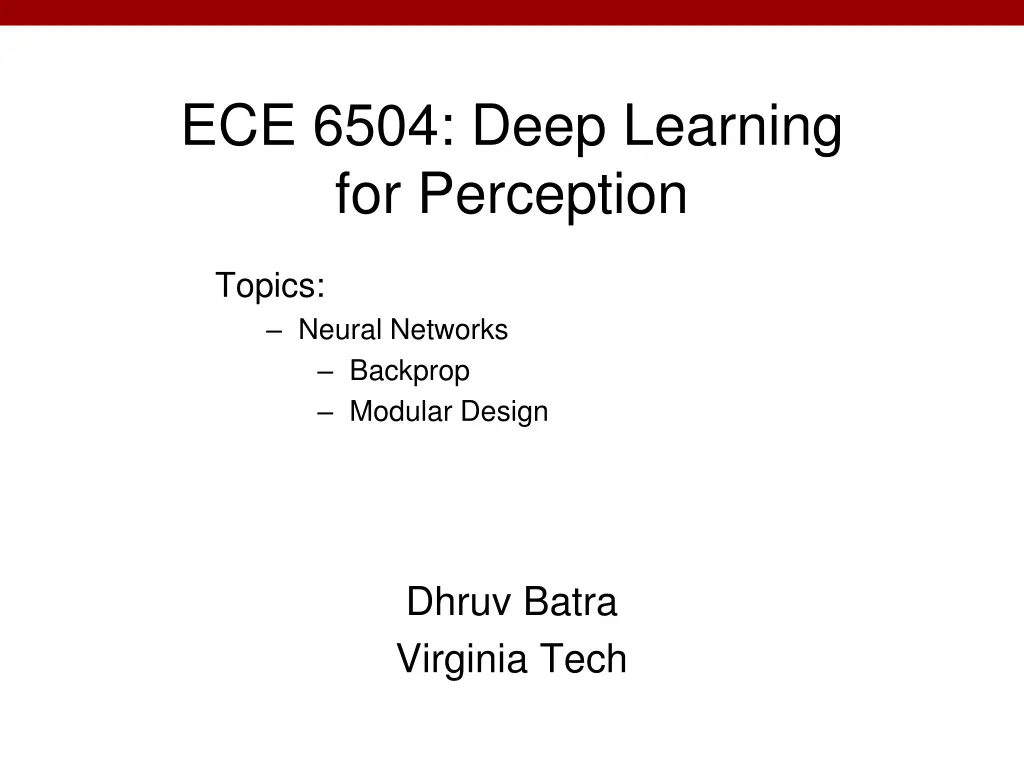
Deep Learning for Perception with Neural Networks and Backprop
"Explore the world of deep learning for perception with topics such as neural networks, backpropagation, and modular design. Learn about supervised learning, error decomposition, and the neuron metaphor for artificial intelligence."
Download Presentation

Please find below an Image/Link to download the presentation.
The content on the website is provided AS IS for your information and personal use only. It may not be sold, licensed, or shared on other websites without obtaining consent from the author. If you encounter any issues during the download, it is possible that the publisher has removed the file from their server.
You are allowed to download the files provided on this website for personal or commercial use, subject to the condition that they are used lawfully. All files are the property of their respective owners.
The content on the website is provided AS IS for your information and personal use only. It may not be sold, licensed, or shared on other websites without obtaining consent from the author.
E N D
Presentation Transcript
ECE 6504: Deep Learning for Perception Topics: Neural Networks Backprop Modular Design Dhruv Batra Virginia Tech
Administrativia Scholar Anybody not have access? Please post questions on Scholar Forum. Please check scholar forums. You might not know you have a doubt. Sign up for Presentations https://docs.google.com/spreadsheets/d/1m76E4mC0wfRjc4 HRBWFdAlXKPIzlEwfw1-u7rBw9TJ8/edit#gid=2045905312 (C) Dhruv Batra 2
Plan for Today Notation + Setup Neural Networks Chain Rule + Backprop (C) Dhruv Batra 3
Supervised Learning Input: x (images, text, emails ) Output: y (spam or non-spam ) (Unknown) Target Function f: X Y (the true mapping / reality) Data (x1,y1), (x2,y2), , (xN,yN) Model / Hypothesis Class g: X Y y = g(x) = sign(wTx) Learning = Search in hypothesis space Find best g in model class. (C) Dhruv Batra 4
Basic Steps of Supervised Learning Set up a supervised learning problem Data collection Start with training data for which we know the correct outcome provided by a teacher or oracle. Representation Choose how to represent the data. Modeling Choose a hypothesis class: H = {g: X Y} Learning/Estimation Find best hypothesis you can in the chosen class. Model Selection Try different models. Picks the best one. (More on this later) If happy stop Else refine one or more of the above (C) Dhruv Batra 5
Error Decomposition Reality (C) Dhruv Batra 6
Error Decomposition Reality (C) Dhruv Batra 7
Error Decomposition Reality Higher-Order Potentials (C) Dhruv Batra 8
Biological Neuron (C) Dhruv Batra 9
Recall: The Neuron Metaphor Neurons accept information from multiple inputs, transmit information to other neurons. Artificial neuron Multiply inputs by weights along edges Apply some function to the set of inputs at each node 10 Image Credit: Andrej Karpathy, CS231n
Types of Neurons Linear Neuron Logistic Neuron Potentially more. Require a convex loss function for gradient descent training. Perceptron Slide Credit: HKUST 11
Activation Functions sigmoid vs tanh (C) Dhruv Batra 12
A quick note (C) Dhruv Batra Image Credit: LeCun et al. 98 13
Rectified Linear Units (ReLU) [Krizhevsky et al., NIPS12] (C) Dhruv Batra 14
Limitation A single neuron is still a linear decision boundary What to do? Idea: Stack a bunch of them together! (C) Dhruv Batra 15
Multilayer Networks Cascade Neurons together The output from one layer is the input to the next Each Layer has its own sets of weights (C) Dhruv Batra 16 Image Credit: Andrej Karpathy, CS231n
Universal Function Approximators Theorem 3-layer network with linear outputs can uniformly approximate any continuous function to arbitrary accuracy, given enough hidden units [Funahashi 89] (C) Dhruv Batra 17
Neural Networks Demo http://neuron.eng.wayne.edu/bpFunctionApprox/bpFunctionA pprox.html (C) Dhruv Batra 18
Key Computation: Forward-Prop (C) Dhruv Batra 19 Slide Credit: Marc'Aurelio Ranzato, Yann LeCun
Key Computation: Back-Prop (C) Dhruv Batra 20 Slide Credit: Marc'Aurelio Ranzato, Yann LeCun
Visualizing Loss Functions Sum of individual losses (C) Dhruv Batra 23
Detour (C) Dhruv Batra 24
Logistic Regression as a Cascade (C) Dhruv Batra 25 Slide Credit: Marc'Aurelio Ranzato, Yann LeCun
Forward Propagation On board (C) Dhruv Batra 26
